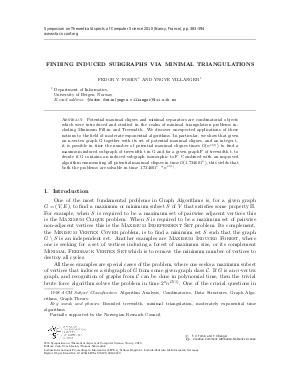Finding Induced Subgraphs via Minimal Triangulations
Authors Fedor V. Fomin, Yngve Villanger
-
Part of:
Volume:
27th International Symposium on Theoretical Aspects of Computer Science (STACS 2010)
Part of: Series: Leibniz International Proceedings in Informatics (LIPIcs)
Part of: Conference: Symposium on Theoretical Aspects of Computer Science (STACS) - License:
 Creative Commons Attribution-NoDerivs 3.0 Unported license
Creative Commons Attribution-NoDerivs 3.0 Unported license
- Publication Date: 2010-03-09
File

PDF
LIPIcs.STACS.2010.2470.pdf
- Filesize: 305 kB
- 12 pages
Document Identifiers
Subject Classification
Keywords
- Bounded treewidth
- minimal triangulation
- moderately exponential time algorithms
Metrics
- Access Statistics
-
Total Accesses (updated on a weekly basis)
0PDF Downloads0Metadata Views
Abstract
Potential maximal cliques and minimal separators are combinatorial objects which were introduced and studied in the realm of minimal triangulation problems including Minimum Fill-in and Treewidth. We discover unexpected applications of these notions to the field of moderate exponential algorithms. In particular, we show that given an n-vertex graph G together with its set of potential maximal cliques, and an integer t, it is possible in time the number of potential maximal cliques times $O(n^{O(t)})$ to find a maximum induced subgraph of treewidth t in G and for a given graph F of treewidth t, to decide if G contains an induced subgraph isomorphic to F.
Combined with an improved algorithm enumerating all potential maximal cliques in time $O(1.734601^n)$, this yields that both the problems are solvable in time $1.734601^n$ * $n^{O(t)}$.
Cite As Get BibTex
Fedor V. Fomin and Yngve Villanger. Finding Induced Subgraphs via Minimal Triangulations. In 27th International Symposium on Theoretical Aspects of Computer Science. Leibniz International Proceedings in Informatics (LIPIcs), Volume 5, pp. 383-394, Schloss Dagstuhl – Leibniz-Zentrum für Informatik (2010)
https://doi.org/10.4230/LIPIcs.STACS.2010.2470
BibTex
@InProceedings{fomin_et_al:LIPIcs.STACS.2010.2470,
author = {Fomin, Fedor V. and Villanger, Yngve},
title = {{Finding Induced Subgraphs via Minimal Triangulations}},
booktitle = {27th International Symposium on Theoretical Aspects of Computer Science},
pages = {383--394},
series = {Leibniz International Proceedings in Informatics (LIPIcs)},
ISBN = {978-3-939897-16-3},
ISSN = {1868-8969},
year = {2010},
volume = {5},
editor = {Marion, Jean-Yves and Schwentick, Thomas},
publisher = {Schloss Dagstuhl -- Leibniz-Zentrum f{\"u}r Informatik},
address = {Dagstuhl, Germany},
URL = {https://drops.dagstuhl.de/entities/document/10.4230/LIPIcs.STACS.2010.2470},
URN = {urn:nbn:de:0030-drops-24708},
doi = {10.4230/LIPIcs.STACS.2010.2470},
annote = {Keywords: Bounded treewidth, minimal triangulation, moderately exponential time algorithms}
}
